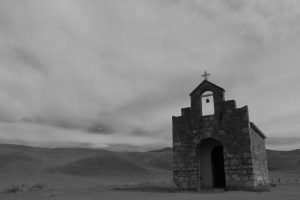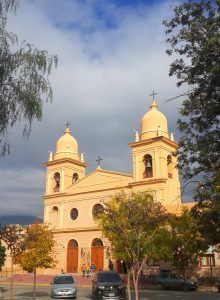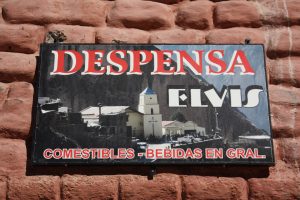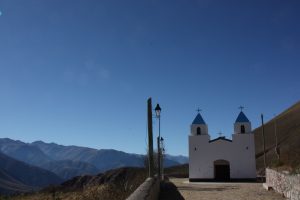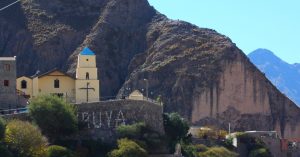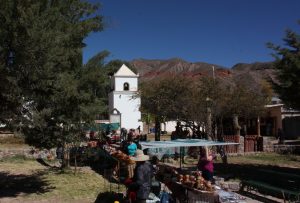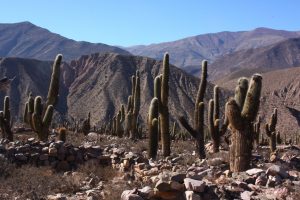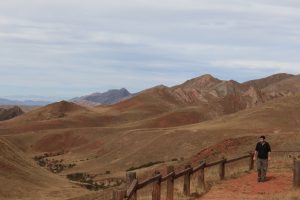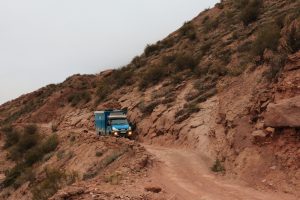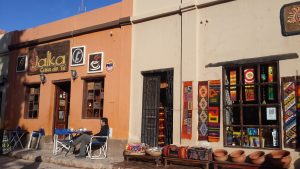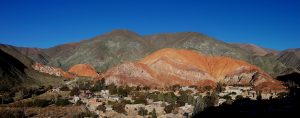At 15,500 ft we crossed from Chile into Argentina over the Paso San Francisco. We’d enjoyed our three days waiting in the high Andes for the border to open, but were looking forward to descending down to rejoin the Ruta 40 highway and the more temperate climate of north-west Argentina. Highlights to look forward to on this next leg of the trip include the wine region around Cafayate, the colonial city of Salta and some reportedly huge cacti in quirky landscapes. Click here for the route map.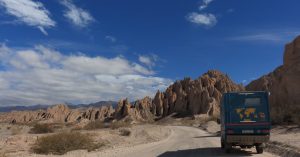
Termas and Turn-around
From the borderline it is around 25km to the Argentine entry border-post, then another 200km of stunning scenery to the nearest town. Fiámbula in the Andes foothills is known for its termas (natural thermal springs) set in the open on a beautiful hillside – we decided to give it a try. In the evening we had to share the termas with a few other visitors, but we parked close to the springs and got up early next morning to have the hot thermal springs all to ourselves. Bliss!
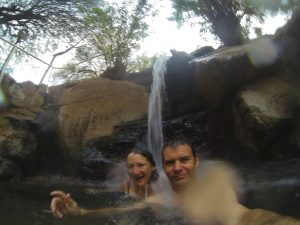
Steaming hot termas
Reluctantly dragging ourselves out of the springs to head north, we decided to try a short-cut on a gravel track which, according to our map and our GPS, would save us around 100 km of boring tarred road. What could possibly go wrong? 🙂 After a promising start, the rough track climbed into the mountains where it narrowed significantly, with a long, sheer drop off the side. Cuthbert rocked along over the bouldery track with very tight hair-pin turns, until we came to a section of track that had been cut out of the rock-face. The track here was just about wide enough for Cuthbert, but the problem was the rock-face over-hanging the track at around the same height as Cuthbert’s roof. To avoid bashing into the over-hang, Marcus had to steer Cuthbert slightly closer to the outer edge of the track than we were comfortable with. I stood out on the track in front to watch the clearance margin and to help guide Marcus and Cuthbert around the over-hang obstacles without going over the edge! Marcus was staying calm and taking it all reasonably in his stride. I, meanwhile, didn’t. This kind of hair-raising driving is generally not my idea of a fun afternoon in the park, but we soldiered on, cruelly deceiving ourselves that it couldn’t get any worse. Ha!
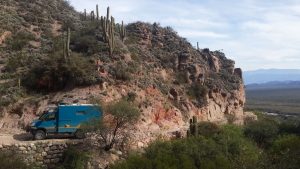
Track starting to get narrow
After three scary over-hang sections, we came to a section of washed-away track where deep, wide water-gullies made the track impassable. Here is where our shared determination to persevere with this route, parted ways. On the one hand, I wanted to take advantage of a tiny but manageable cutting out of the rock into which a 6 or 8 point-turn would send us back in the direction we had come. Marcus meanwhile, wanted to try to rebuild the washed-away track to allow us to continue.
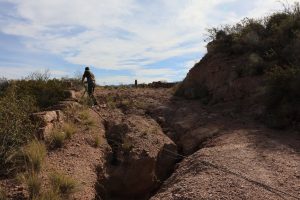
Then it gets tricky
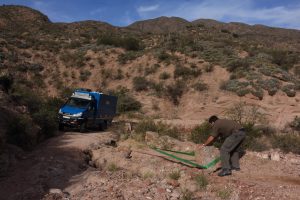
Winching boulders
Whilst Marcus was using the winch to haul huge boulders into the deep crevices in the road, I took a short walk ahead to try to establish whether more such civil engineering would be required further on. I couldn’t see the road surface ahead very far, but I could see that we were only around half-way up the mountain, and after that we still had to descend down the other side. The precarious track and the uncertainty of potentially even scarier sections to come, forced what might tactfully be described as a ‘Domestic Debate’, the up-shot of which was us taking advantage of the aforementioned turn-round opportunity! We re-traced our path back around the over-hangs and down into the valley where we parked up overnight. Next morning when we finally got back to the junction with the main tar road, we noticed a small sign partially hidden by a bush which we had not noticed the day before: ‘Mountain Road – Impassable’. Conclusion: a basic systems failure causing a breach of Overlanding Rule No. 1 – Read the signs!
Going the long-way round, we joined the north-bound Ruta 40 and some 100km later we took a side-track into the hills to visit some more thermal springs marked on our map (this time checking for any hidden signs at the junction!). The route up there was almost as scary as the track the day before, but it was only 4 km and the previous day’s experience had probably steeled my tolerance for such narrow, rock-face mountain tracks. Sadly, the effort to get there was really not rewarded with an amazing termas experience. It was badly maintained with rubbish around. Oh well – you win some, you lose some!
Wine again
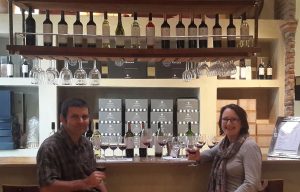 After a few days of hill-side bashing and visiting the interesting historic ruins of Shincal and Quilmes (Shincal was apparently the most southerly out-post of the Inca empire, centred in Cusco, Peru), we reach Argentina’s second largest centre of wine-making – Cafayate. Regular readers may be detecting a bit of a wine theme over the last few weeks: the vineyards of Mendoza and the Pisco distilleries of the Elqui Valley, now this. But honestly, it’s not our fault that they put these attractions directly in our route!!
After a few days of hill-side bashing and visiting the interesting historic ruins of Shincal and Quilmes (Shincal was apparently the most southerly out-post of the Inca empire, centred in Cusco, Peru), we reach Argentina’s second largest centre of wine-making – Cafayate. Regular readers may be detecting a bit of a wine theme over the last few weeks: the vineyards of Mendoza and the Pisco distilleries of the Elqui Valley, now this. But honestly, it’s not our fault that they put these attractions directly in our route!!
 Cafayate is a very pleasant and chilled-out small town (nice plaza, cafés etc) but the beauty of Cafayate compared to other wine-making regions is that several of the bodegas (wineries) are actually in the town, so no need to drive between vineyards. We chose two local wine producers to visit: the larger Hermanos Domingo producing quite large quantities of mid-quality wines; and the smaller ‘boutique’ Bodega Porvenir producing far fewer bottles and (allegedly) higher quality wines. The interesting outcome for us was that although the visit experience was far better at Bodega Porvenir (a much more personalised tour and guided tasting of more wines), we didn’t particularly prefer their produce to the more mass-market Hermanos Domingo (probably a sign of our unsophisticated palate!). Now… we’d hate to give the impression that we are in any way connoisseurs or know what we are talking about here, but from our extremely limited sample of Argentinian wines, our favourites were: for the whites – pretty much anything made from the Torrontes grape; and for the reds – the Hermanos Domingo Marlbec Reserva 2014. So that’s our considered advice 🙂 ! If you see them in Sainsbury’s, give them a try!
Cafayate is a very pleasant and chilled-out small town (nice plaza, cafés etc) but the beauty of Cafayate compared to other wine-making regions is that several of the bodegas (wineries) are actually in the town, so no need to drive between vineyards. We chose two local wine producers to visit: the larger Hermanos Domingo producing quite large quantities of mid-quality wines; and the smaller ‘boutique’ Bodega Porvenir producing far fewer bottles and (allegedly) higher quality wines. The interesting outcome for us was that although the visit experience was far better at Bodega Porvenir (a much more personalised tour and guided tasting of more wines), we didn’t particularly prefer their produce to the more mass-market Hermanos Domingo (probably a sign of our unsophisticated palate!). Now… we’d hate to give the impression that we are in any way connoisseurs or know what we are talking about here, but from our extremely limited sample of Argentinian wines, our favourites were: for the whites – pretty much anything made from the Torrontes grape; and for the reds – the Hermanos Domingo Marlbec Reserva 2014. So that’s our considered advice 🙂 ! If you see them in Sainsbury’s, give them a try!
One thing that has surprised us slightly on this South American journey is how few other overlanding travellers we have met on the way. We have met a few in the key destinations (e.g. Santiago) but generally we have met fewer than we expected on the road. So it was a pleasant surprise whilst parked up in Cafayate, to meet fellow overlander Dave from Washington State, USA. It was great to sit in Cuthbert and exchange travellers’ tales over a chummy beer with Dave.
Salta
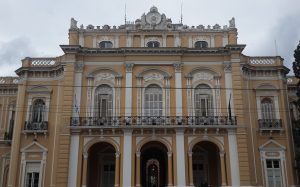
Grey day in Salta
From Cafayate to the north, we spent a few days passing through some great scenery and interesting rock formations until we finally descended into the city of Salta. It’s a large city with a colonial history and is said to be a highlight on the itinerary of many travellers to the region.
We’re never sure where to park-up for the night when we visit cities. Parking on the street or in city-centre car-parks can be noisy, or unsafe, or both. Whereas countryside park-spots are usually so far out of town that you waste half a day sitting in commuter traffic coming into town to see the sights. For Salta we decided that the only option was to go to a municipal campsite close to the town centre. The write-up for the site was not exactly flattering (which turned out to be highly accurate) but we found several other overlanders had also decided that it was the only option in town. At the campsite Cuthbert sat alongside a huge Actionmobil truck-camper with a hydraulically raised living space; a large Unicat 6-wheel drive Duco truck; and a very smart Bremach camper of a similar size to Cuthbert – all Swiss registered. Cuthbert often towers over all the other campers in a site and isn’t accustomed to being one of the smallest trucks in the yard!

Cuthbert makes new friends in Salta
As a city, we found Salta to be slightly disappointing after our expectations had been raised by the travel books. There is indeed a lovely central square with a nice cathedral and some top-notch colonial architecture, but the rest of the city lacked for us the ‘cool’ atmosphere that we had really enjoyed further south in Mendoza. It was difficult to take any attractive photos of the nicest parts of Salta city as the sky was overcast and the light was poor!
Tropical Altitude
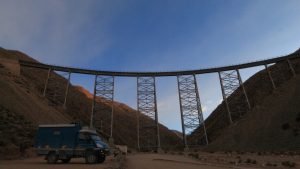
Night stop by a viaduct at 4,100m
From Salta we headed north-west following alongside a train-track, some 160km to the small town of San Antonio de Los Cobres. Two things escaped our attention on this drive. First, the long, gradual climb of the route had deceived us into thinking we hadn’t climbed much in altitude from Salta (we had in fact climbed almost 3,000 metres). Secondly, the ‘base-height’ from which we had set off in Salta was already 1,100 m. The mathematically astute reader will by now have calculated that we had parked-up for the night at an altitude of 4,100 m. This is over 400 m higher than our highest camp so far on the San Francisco Pass and we feel the effects of this with a restless night’s sleep! We should (in theory) adjust to the altitude as we spend more time up here and acclimatise, but for now we do feel it a bit!
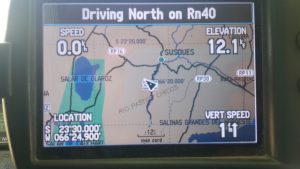
Going tropical
Next leg from San Antonio is to re-join Ruta 40 into the highlands. And here’s some news… we are now officially ‘in the tropics’! Yes, driving north on Ruta 40 near the small town of Susques, we crossed the Tropic of Capricorn at 23°30’ South. As we are at over 12,000ft asl, it doesn’t feel tropically toasty outside and we won’t be donning our flip-flops and Hawaiian shirts just yet. When we got up that morning it was -4C and light snow falling! Actually we are not entirely sure exactly when we crossed the precise line. Our GPS ‘tropic line’ didn’t agree with the one our maps and there was no sign at the side of the road, but at some point in the vicinity of Susques, we ‘went tropical’.
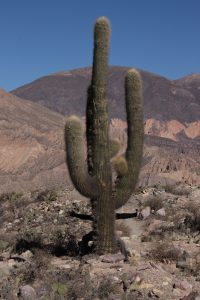
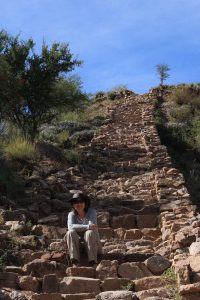 The scenery is great up here in far-north Argentina, but to be honest, we are gradually becoming ‘Wow-Weary’ 🙂 Other travellers may be familiar with this phenomenon. After six months of touring Patagonia and zig-zagging numerous times across the Andes, we have been through some of the most spectacular scenery in world. We never tire of the vistas, however we are becoming a tougher audience for the landscape to impress! We visit the quaint tourist village of Purmamarca with pink-striped mountains, then north up the RN9 through Tilcará, Uquía, Humahuaca and on to Iruya. Our guide book hails this drive as ‘one of the most spectacular drives in Argentina’; we’d say it was ‘nice’ 🙂
The scenery is great up here in far-north Argentina, but to be honest, we are gradually becoming ‘Wow-Weary’ 🙂 Other travellers may be familiar with this phenomenon. After six months of touring Patagonia and zig-zagging numerous times across the Andes, we have been through some of the most spectacular scenery in world. We never tire of the vistas, however we are becoming a tougher audience for the landscape to impress! We visit the quaint tourist village of Purmamarca with pink-striped mountains, then north up the RN9 through Tilcará, Uquía, Humahuaca and on to Iruya. Our guide book hails this drive as ‘one of the most spectacular drives in Argentina’; we’d say it was ‘nice’ 🙂
Adios Argentina!
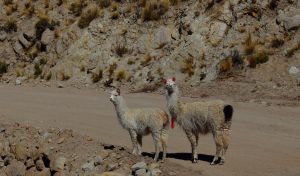
Inquisitive llamas ‘Who is this Cuthbert chap?’
We keep heading north until, at the small town of Abra Pampa, we have almost reached the end of Argentina. We are just 50 km from the Bolivian border, but before we head into Bolivia we want to hop over the Andes (again!) to finish the far north of Chile. We decide to turn west and re-join the Ruta 40 for the final time; this time it’s a short section south-bound to reach the Paso Jama to Chile.
The north-west of Argentina has been an interesting final sector of our tour of the country. Up here there is a distinctly different culture to that of southern Argentina. We have seen a gradual change of culture towards what we expect to see in the Bolivian and Peruvian Andes. In southern Argentina, the proud ‘alpha-male’ gaucho gallops the pampas on a fine steed, lassoing and herding his cattle and sporting his ‘Che Guevara-style’ beret. Here in the north, local farmers sport ponchos and wide-brimmed hats and trot along the road-side on donkeys, maybe with a few llamas in-tow. The people in the far northern villages are far less ‘Latino’ and more ‘Andean’ in appearance. There are llamas roaming the mountains rather than guanacos, and llama meat features heavily on most menus. Marcus has tried it already, I still have that dubious delight to come… somewhere!
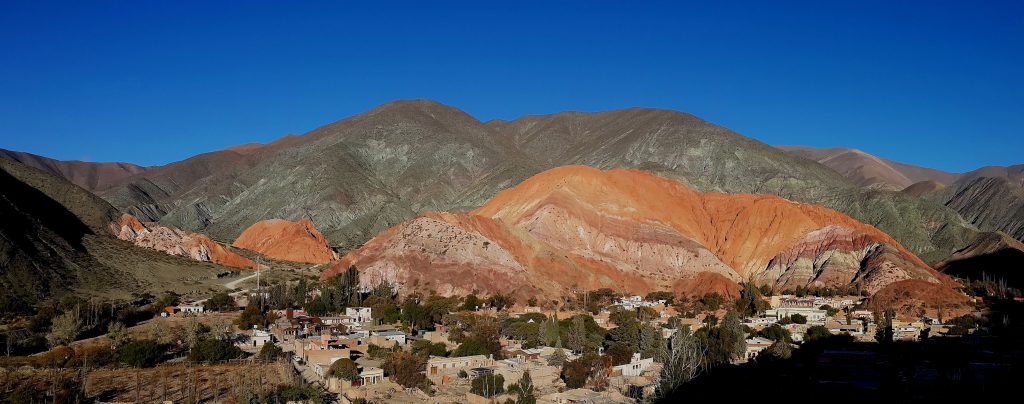
Rainbow rocks – Purmamarca
Our very final road in Argentina is the RP77, a rough cross-country track taking us to the most northerly border crossing between Argentina and Chile at the Paso Jama. It is a slow-going, particularly remote and little travelled track, not shown on many maps, crossing a hauntingly stark and wind-swept landscape. There isn’t a cloud in the sky and the llamas stare inquisitively at us as we bounce past on the rough road. At over 14,000 ft (4,000m) asl, we park-up by a small deserted salt-lake for the night with a few llamas for company. Even for us ‘wow-weary’ travellers, this is a beautiful and fitting place for our final night in Argentina.
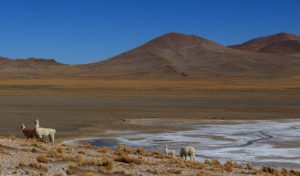
View from Cuthbert – last night in Argentina
So what have we made of Argentina after six months of dipping in and out of the whole length of the country? Well, we liked it very much. The country and its friendly people are refreshingly accepting of itinerant travellers (yes, even Brits!). We never felt anything other than warmly welcome wherever we went in Argentina. Distances are huge and there is an awesome amount to explore: amazing landscapes and wildlife, atmospheric cities, great food and wine, friendly people. It is unfortunate that it’s economy is suffering so much, which can cause some practical difficulties and the country seems somehow ‘broken’ (or at least ‘Temporarily Out of Order’). There is a sense here that it was, once upon a time, much more than it now is. And it could, in the future under the right management, be so much more. We truly wish Argentina all the best under its newly elected management. The lovely people that we have met deserve a prosperous future and we wouldn’t hesitate to come back one day to see how things are going here.
Next, we’re going to finish Cuthbert’s ‘Gran Tour de Chile’ before moving on to Bolivia. Adios Argentina!
Link to next blog: Chile Finale Link to full South America Blog
North-west Argentina Gallery
- View from Cuthbert – last night in Argentina
- Grey day in Salta
- DCIM100GOPRO
- Rainbow rocks
- Winching boulders

